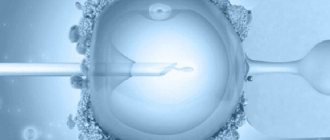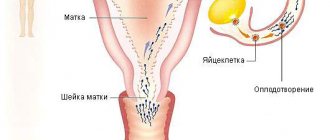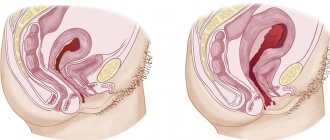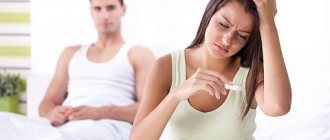Features of ovulation after 40 years:
Age is one of the main factors affecting a woman's ability to conceive. The supply of oocytes in the body is limited. It lays at the stage of embryonic development. Some eggs die during adolescence. The remaining oocytes are used up with each menstrual cycle. Therefore, by the age of 40, there are very few eggs left. The functioning of the reproductive organs changes dramatically during this period. This affects the overall well-being of a woman.
Ovulation after 40 years occurs much less frequently than at a younger age. This is due to a physiological decrease in estrogen levels in the body. The hormone is responsible for the maturation of eggs and an increase in the thickness of the endometrium. In addition, he is responsible for preserving youth. When estrogen production is disrupted, a change in the duration of the menstrual cycle is observed. For some women it disappears completely. A lack of estrogen in the body is accompanied by the following symptoms:
- Deterioration of skin elasticity;
- Frequent mood changes;
- Decreased libido;
- Change in the nature of discharge.
Methods for determining ovulation
How to find out when ovulation occurs and what a woman can feel during this period? There are many ways to determine the ovulatory period. One of them is the above-mentioned method - measuring rectal temperature.
This method is carried out at home and is the cheapest method. To determine the period of ovulation at home, you will need a piece of paper (preferably in a box), a pen, a thermometer (electronic or mercury) and sleep for at least 6 hours.
Every morning, at the same time, without getting out of bed and without making rough, sudden movements, you need to insert a thermometer into the rectum for 5-7 minutes. You should not try to insert the thermometer as deeply as possible - 2-3 cm of depth is enough.
Each measurement must be displayed on a piece of paper, lined with columns: a temperature column (vertical) and a month column (horizontal). A dot is placed at the intersection of the date of the month and a certain temperature mark. The next day, a new measurement is recorded, a new point is placed and connected to the previous point by a line. And so on until the end of the cycle.
By the end of the month, a graph is obtained that shows when the temperature dropped and when it rose. A few days before ovulation, the temperature drops, then there is a “jump” in LH, and after that the temperature rises and remains almost until the onset of the next menstruation. 2-3 days before the start of a new cycle, the temperature also decreases.
How do you know if ovulation is happening if you don’t want to wake up every morning at the same time without getting out of bed or making sudden movements? You can use an ultrasound drug. A few days before the onset of expected ovulation, it is necessary to perform a gynecological ultrasound.
On the monitor, the doctor will be able to see in which ovary the dominant follicle is maturing, what size it has already reached, after how many days ovulation will occur and whether it will happen at all (that is, whether this is an anovulatory cycle), etc. The examination should be repeated every 2-3 days until the period when the egg leaves the ovary, as well as one day after this period. The ultrasound measurement process is called folliculometry.
Feeling the cervix can help track ovulation. Before ovulation, the cervix has a loose, soft texture, and there is also a large amount of cervical mucus, reminiscent of egg white. Mucus helps sperm that enter the vagina feel more comfortable in it and move faster towards their intended goal. Before menstruation, on the contrary, the cervix hardens and rises high. The entrance to it is tightly closed so that no foreign bodies can penetrate there. Its only drawback is the high cost of tests.
Life expectancy of an egg after ovulation in a woman’s body after 40 years
Doctors say that ovulation after 40 years rarely leads to a successful pregnancy.
This is due to a reduction in the lifespan of the egg after it leaves the follicular walls. Until the age of 40, she lives on average 24-48 hours. With age, this figure decreases noticeably. Pregnancy in this case becomes possible if the man’s sperm are sufficiently active. In other cases, specialist help may be required.
Symptoms of ovulation in women 40 years old:
In general, ovulation after 40 years does not have any special distinctive features. It proceeds the same way as before. Some women do not notice any characteristic symptoms of the fertile period. It may be accompanied by the following symptoms:
- Increased sexual desire;
- Heaviness in one of the ovaries;
- Flatulence;
- An increase in the volume of vaginal discharge and a change in its consistency;
- Increased sensitivity of the mammary glands;
- Increased sense of smell and taste.
Painful sensations in the appendage area begin 2-3 days before the follicle ruptures.
Every day they become more intense. The discharge becomes mucous and transparent. Just before ovulation, cervical mucus thins. Libido increases noticeably. Mood swings may also occur.
As fertility increases, the position of the uterus changes. It rises high in the vagina and becomes softer. The throat of the cervix opens slightly. This is necessary for the smooth penetration of seminal fluid into the genital tract. At the same time, the basal temperature decreases. It can be detected early in the morning, after waking up. Measurements are taken with a mercury thermometer in the rectal orifice.
Ovulation after 40 years and beyond is easy to determine by ultrasound. It is recommended to monitor starting from the 12th day of the cycle. The following signs indicate the rapid rupture of a follicle with a mature egg:
- The presence in one of the ovaries of a dominant follicle measuring more than 18 mm;
- The thickness of the endometrium exceeds 10 mm;
- The cervix opens.
An ovulation test can help provide additional information. It responds to an increase in the hormone LH in the body. But the result should be interpreted in conjunction with other signs of ovulation. LH can increase not only during the fertile period, but also in the presence of gynecological diseases.
After expected ovulation, the woman should visit the ultrasound again. The fact that the follicle has successfully ruptured is indicated by its disappearance and the presence of fluid behind the uterine cavity. In place of the follicle, a yellow body appears, which has uneven outlines. The absence of characteristic signs of the ovulatory period indicates luteinization of the follicle. This problem requires adjustment of hormonal levels with medications.
The first signs of approaching ovulation after 30
Signs of ovulation in women can be determined by a gynecologist or by the patient herself at home. This is necessary for those who want to avoid unwanted pregnancy or, on the contrary, strive to conceive a child. Symptoms:
- Increase in basal temperature. This indicator includes body temperature, which is the maximum. At the same time, the woman should feel good, rested and well-slept. At the moment when the egg enters the fallopian tubes, the temperature can increase to +37...+37.3°C. This means the onset of the fertile period. Therefore, women need to periodically measure their body temperature to determine the maximum.
- Changes in mucous secretions. The genital tract constantly produces cervical mucus, which is necessary for the movement or blocking of sperm. When ovulation occurs, the mucus should be transparent in structure, resembling egg white. This is a favorable environment for the movement of sperm and eggs. Male reproductive cells do not die.
- Changes in the location of the cervix. This indicator can only be determined by a gynecologist. During the period outside of ovulation, the cervix acts as a barrier that prevents the passage of sperm. When the fertile period begins, the cervix slightly changes its location, due to which sperm can easily penetrate inside.
- Bloody issues. Many women during periods when they are not menstruating believe that spotting is a symptom of illness. But that's not true. The condition may indicate the beginning of the release of the egg into the tubes. Due to this, the level of estrogen in the body decreases, causing minor bleeding.
- Increased libido. It is believed that this is a signal from the body that it is ready for fertilization. This mechanism is genetically laid down for procreation.
- Increase in the size of the mammary glands. During ovulation, the number of sex hormones increases so that the egg can freely enter the tubes for fertilization. Due to hormonal changes, the volume of the mammary glands increases. This happens insignificantly, but most patients feel this condition.
- Lower abdominal pain. The condition resembles menstrual cramps. Many patients are worried, believing that this is a sign of pathology. Soreness for 1 day is considered normal for the egg release process. If the pain is severe or lasts more than 2 days, you should get tested and examined.
- Increased sense of smell. This occurs due to hormonal changes during ovulation. Additionally, taste preferences may change.
- Gastrointestinal disorders. They may be accompanied by bloating, flatulence, and diarrhea. The condition develops due to hormonal changes that lead to changes in water and electrolyte metabolism.
- Crystallization of saliva. The process is carried out by increasing the amount of luteinizing hormone. This has been proven by studies carried out under a microscope. Crystals appear in saliva, resembling frost on glass.
How often do women ovulate after 40?
The frequency of ovulation in women over 40 years old depends on a combination of factors. These include hereditary predisposition, hormonal levels, a woman’s lifestyle and concomitant diseases. For some women, there are no significant changes at this age. For others, the frequency of ovulatory cycles can be only 3-4 times per year. To determine the degree of readiness of the egg for fertilization, you should attend an ultrasound examination.
Read more Conization for grade 3 dysplasia reviews
How to seize the moment?
Every woman ovulates on approximately the same day of her cycle.
Which of them is the second question. There is a simple calculation that you need to start from. Each woman's egg matures and is released approximately 14 days (plus or minus 2 days) before the next menstruation begins. And what day it will be from the date of the start of the last menstruation depends on the length of the cycle of a particular woman.
This is where all the complexity of calculating ovulation using the calendar method lies. If you have a 28-day cycle, ovulation occurs around day 14 of your cycle. If your cycle is 32 days - on the 18th day of the cycle, and so on.
Based on this knowledge, you can calculate the date of ovulation using an online ovulation and conception calculator. But, if a woman has an irregular cycle, then its length changes each time, for example, from 30 to 40 days, and it is almost impossible to calculate ovulation in this way. That’s why they came up with ovulation tests and the basal temperature method, which help in realizing our maternal destiny. But more on that later.
Interesting! Saddle uterus: is there a chance of getting pregnant?
There are terms such as early and late ovulation.
If the egg is released, for example, on the 12th day instead of the 14th day of the menstrual cycle, then this ovulation is early. Therefore, late ovulation is when the egg is released later than the middle of the cycle. There are several reasons for such phenomena:
- Irregular periods
- Hormonal disbalance
- Postpartum period
- Regular stress
- Post-abortion
- Gynecological diseases
- Premenopausal period in women over 40 years of age.
Reasons for the periodic absence of ovulation after 40 years
Ovulation after 40 years may be absent for a long time. This is due to hormonal changes. But in some cases, anovulation is provoked by gynecological diseases or poor lifestyle. Ovarian dysfunction can be a consequence of excessive alcohol consumption and smoking. Other possible reasons for the lack of ovulation include:
- Inflammatory process in the pelvis;
- Sexual infections;
- Polycystic ovary syndrome
Sexual infections - description
If anovulation is provoked by external factors, there is the possibility of artificial stimulation of ovarian function. For these purposes, hormone-based medications are taken.
The complete absence of ovulation after 40 years of age indicates early menopause. Its cause is genetic disposition. In this case, the likelihood of conception decreases. Menopause is characterized by the complete disappearance of menstruation. With the help of specialized medications, a woman can smooth out the symptoms of menopause. They are prescribed by the attending physician, based on the woman’s health condition.
Each age has its own characteristics of the menstrual cycle. The presence of ovulation on certain days indicates the possibility of conceiving a child. After 40 years, some changes can be observed. The duration of ovulation is reduced, and specific symptoms accompany it. Menstrual irregularities may indicate various pathologies. Therefore, it is important to know what the characteristics of the condition and symptoms are during ovulation in women 40 years old.
What to do with ovulatory dysfunction?
- Visit a doctor. Even if you do not intend to become pregnant, irregular ovulation may be a sign of a serious illness that needs to be treated as soon as possible. The absence of ovulation in itself is not a separate disease, and a couple of “empty cycles” per year are considered normal. So it is much more important to understand why exactly it does not occur. If there are problems, the gynecologist will look for the true cause of anovulation and select treatment for the original disease.
- Take your medications correctly. No self-medication please! The reproductive system is too delicate and complex a mechanism. It is very easy to break, but much more difficult to repair.
- Lead a healthy lifestyle. Weight control, giving up alcohol and cigarettes, getting enough sleep, and minimizing stress can help normalize reproductive functions just as much as taking pills.
- Avoid excessive training.
- Avoid extreme diets. During fasting, certain hormones are released that help break down the body's reserves to compensate for losses. Thus, hormonal levels are disrupted, which in turn leads to disruption of the menstrual cycle.
Dear women! Treat your body with care and respect. Be healthy and happy. I wish everyone planning an easy pregnancy, trouble-free childbirth, strong children and good nights!
Don't forget to subscribe to updates and share your favorite articles with your friends!
Features of ovulation after forty years
The older a woman gets, the lower the percentage of successful conception. After 40, the body prepares for menopause, and this can last for years. The onset of the oocyte maturation stage during this period occurs less frequently, and almost every attempt at conception becomes impossible.
p, blockquote 3,0,0,0,0 –>
Some cycles are accompanied by a lack of ovulation, which leads to many unsuccessful attempts at fertilization. However, after the age of 40, this is quite possible, but you have to make more attempts. h2 2,0,0,0,0 –>
Frequency of ovulation
Not all women know how often and whether ovulation occurs every month. In gynecological practice, there is such a thing as an anovulatory cycle. This is a cycle when the ovaries “rest” and the follicle does not mature in them. Accordingly, the release of the egg also does not occur. In a healthy, normal woman, ovulation occurs every month, with the exception of 2-3 months when anovulatory cycles occur.
And again, it should be noted that when keeping a chart for measuring basal temperature, the anovulatory cycle will be noticeable immediately - in such a chart there is no “jump” in LH, the lines represent a solid “fence”, without a low drop and high rise in temperature.
Late or early ovulation
As mentioned above, ovulation in a healthy woman with an established menstrual cycle occurs approximately in the middle of the cycle. However, gynecologists sometimes use epithets such as “late” or “early” ovulation.
That is, the process of the release of the egg from the ovary occurs earlier or later than the due date. That is, if, for example, with a 28-day cycle, ovulation occurs on the 13-14th day, then with early ovulation it will occur on days 8-10, and with late ovulation - on 18 and subsequent days.
The reasons for early or late ovulation, according to experts, are severe stress, poor diet, rhythm of life, various diseases, taking any hormone-containing medications, change of environment (for example, a long flight), etc.
Also, the cause of early ovulation may be a malfunction of the hypothalamus. If for any reason it begins to produce an excessive amount of gonadotropin, the pituitary gland will regard this as a sign of the production of hormones that provoke the early onset of the ovulatory period.
Life expectancy of an egg after ovulation in a woman’s body after 40 years
Normally, an egg lives for 24 hours. After 40, this time is reduced by half or even more, making conception almost impossible. But experts note that there is no need to despair, because by following some rules, you can increase the viability of the egg. The lifespan of oocytes after ovulation in a woman’s body after 40 is less than 24 hours, but sufficient for successful fertilization. p, blockquote 5,0,0,0,0 –>
p, blockquote 6,0,1,0,0 –>
How to increase the lifespan of an egg:
- avoid stress, lead a calm lifestyle, think positively;
- refuse hormonal medications unless prescribed by a doctor;
- be regularly examined by an endocrinologist.
Experts recommend improving reproductive health after 35 years. Even if pregnancy is not planned, this will have a beneficial effect on your overall well-being. p, blockquote 8,0,0,0,0 –>
The egg cell in the follicle grows until lutein reaches its maximum concentration. Once this happens, the follicle ruptures. From this moment on, the egg is ready for conception, but its life expectancy is reduced. If conception does not occur within a certain time, she dies. h2 3,0,0,0,0 –>
What is ovulation?
Ovulation is one of the stages of the menstrual cycle. This is the peak of a woman's fertility. During ovulation, a mature egg is released from the ovary into the fallopian tube, where it is ready to meet the sperm. If fertilization occurs within 24 hours, pregnancy occurs. If not, the egg is destroyed, the body rejects it along with the blood and endometrium: this is menstruation. After menstruation, the cycle repeats.
Since sperm remain viable in the fallopian tubes for 3 to 7 days, conception can occur even if sexual intercourse occurs before ovulation. Taking all factors into account, on average a woman can become pregnant within 5-6 days every month. This period of time is called the "fertility window"
Symptoms of ovulation in women 40 years old
The first main sign of the beginning of this period will be a change in the consistency of vaginal discharge. They become transparent and more viscous. After 40 years, the difference is that the altered cervical mucus is actively secreted for 1-2 days, in young people - about 4-5 days.
p, blockquote 10,0,0,0,0 –>
When ovulation occurs, other important signs appear:
- an increase in basal temperature is a sign of the egg’s readiness for fertilization, which, when measured regularly, helps a woman determine the time when the oocyte begins to mature;
- discomfort and mild pain in the lower abdomen - this symptom does not appear in all women, but sometimes becomes pronounced, as during menstruation;
- increased sense of taste, improved sense of smell;
- hormonal changes - this indicator allows you to determine the onset of ovulation using special tests.
p, blockquote 11,0,0,0,0 –>
Such manifestations are typical for women of childbearing age. After 40, some of them may be absent, while others may become worse. In addition, swelling may appear, headaches and irritability may occasionally occur. p, blockquote 12,0,0,0,0 –>
https://www.youtube.com/watch?v=gfz0nyckwMQ p, blockquote 13,1,0,0,0 –>
In addition to the sensations during ovulation, the signs will also be some indicators of ultrasound, as well as blood and saliva tests. On an ultrasound, the doctor observes an expansion of the uterus and an enlargement of the follicle. The level of sex hormones increases in salivary fluid and blood.
A few more ways to accurately determine the onset of the desired phase:
- Charting your basal temperature. Throughout your cycle, you should measure your temperature in your mouth, vagina, or rectum. During ovulation it exceeds 36.6.
- Using test strips. Special tests can be bought at the pharmacy; upon contact with urine, the sensor determines the level of hormones, showing a positive or negative result.
- Conducting laboratory tests. A change in the amount of hormones (progesterone) in the blood will accurately indicate the period of ovulation.
- Undergoing an ultrasound examination. Ultrasound shows changes characteristic of the onset of the fertile phase and ovulation.
Read more Interferon for hepatitis C price
h2 4,0,0,0,0 –>
Does ovulation always occur in the middle of the cycle?
There is an opinion that ovulation must occur in the middle of the cycle. In fact, this statement is erroneous. The day the follicle ruptures depends on the length of the menstrual cycle . It is different for all women.
The cycle is conventionally divided into two phases: follicular and luteal. The first lasts until ovulation, and the second after.
The follicular phase can vary from 7 to 22 days. With a 28-day cycle, it is 12–14 days. But there are also significant deviations from this norm. The luteal phase , in most cases, is always the same and includes two weeks +/- 2 days. The moment the egg is released most depends on the amount of estrogens that affect the growth of follicles in the first phase.
To find out the approximate date of ovulation, observations should be made over several cycles. Various programs and applications help with this. They calculate the average automatically. You can do this yourself. Subtract 14 from the number of days in the cycle The resulting number will indicate the approximate day on which the follicle burst.
If the menstrual cycle lasts 35 days, then the release of the egg in this case will occur on the 21st day +/- 2 days. Such ovulation is called timely for such a cycle length. But if the female reproductive cell matures later than 23 days, then such ovulation will be considered late.
There is such a term as early ovulation. In this case, follicle rupture in a 35-day cycle occurs earlier than the 19th day. Most often, this phenomenon causes an increase in the amount of estrogen. The following situations can speed up the release of an egg:
A woman can determine ovulation by a number of indirect signs. These include painful sensations in the lower abdomen and in the ovarian area, increased sexual desire, the appearance of “egg white” type discharge, and an increase in basal temperature. But folliculometry will be more reliable. It is an analysis of the size of the follicle using ultrasound .
Some women use tests to determine ovulation. They respond to the release of hormones characteristic of the period of follicle rupture.
Another way to determine the release of an egg is to study the position of the cervix. During the fertile period, it becomes soft, open and moist, and occupies a high position.
The presence of ovulation is not only a prerequisite for successful conception, but also one of the guarantors of the health of the reproductive system. Confirmation of the fact of ovulation is necessary when planning pregnancy and for diagnosing various diseases. Therefore, every woman should observe the cyclical nature of internal processes.
Ovulation (from the Latin ovulla - “testicle”) is the release of a mature female cell (egg) from the ovarian follicle into the abdominal cavity. Ovulation is necessary so that a woman of childbearing age can find the happiness of motherhood, or, simply, give birth to a child.
Without the release of an egg from the ovary, fertilization by sperm is impossible, and therefore conception is impossible. Surely, many women and girls will be interested in knowing what happens during ovulation, how often this process occurs, and what to do if ovulation does not occur?
Reasons for the periodic absence of ovulation
After 40, the periodic absence of the oocyte maturation phase is a pattern. This is due to hormonal changes, metabolic disorders, and stress.
p, blockquote 16,0,0,0,0 –>
What can become a factor in the periodic absence of ovulation:
- development of inflammatory diseases during egg maturation;
- heavy physical labor, which is a strong stress;
- change in climatic conditions, travel to another country;
- lipid metabolism disorders;
- psychological shocks;
- long-term use of hormonal drugs.
p, blockquote 17,0,0,0,0 –>
These factors worsen reproductive health, reducing the likelihood of timely maturation of the female cell. Often the cause is long-term use of hormonal contraceptives. After their withdrawal, the body still needs some time to normalize hormone production. p, blockquote 18,0,0,0,0 –>
Improper lipid metabolism also affects the process of egg maturation. Sudden weight loss or weight gain affects the production of hormones. An insufficient amount of adipose tissue leads to an imbalance of reproductive cells, which is why thin people are more likely to experience periodic absence of ovulation. p, blockquote 19,0,0,1,0 –>
A long trip or moving to other climatic conditions will be stressful for the female body, which leads to hormonal imbalance. The changes are not noticeable outwardly, but are manifested in irregular ovulation. p, blockquote 20,0,0,0,0 –>
The complete absence of the release phase of a mature egg indicates the onset of menopause, when conception is no longer possible. Menopause can begin at any age, even in young women, which will be a deviation. In any case, you need to consult a doctor to promptly identify possible deviations. The gynecologist will also give recommendations on how to improve well-being during the early menopause, which is accompanied by a number of unpleasant symptoms. h2 5,0,0,0,0 –>
Cyclicity of ovulation
The process of egg maturation is based on the action of hormones. They are produced by the adrenal glands, pituitary gland and endocrine system. The growth of estrogen stimulates the maturation of the egg. Follicles can grow in one or both ovaries at once.
Ovulation is characterized by the rupture of the follicle at the moment when it reaches the required size. The fluid that is in the follicle during the growth period washes the mature egg into the abdominal cavity. Ovulation makes the process of fertilization possible. A prerequisite is the presence of sperm. If the egg does not enter the abdominal cavity, then conception is impossible.
Normally, ovulation occurs once during one menstrual cycle . But much depends on the individual parameters of the body. The process of maturation and release of the egg can be influenced by various factors.
Even a completely healthy woman does not ovulate every month. Normally, anovulatory cycles are allowed twice a year.
With certain diseases, egg maturation may occur rarely or completely absent. In this situation, effective treatment is necessary. Otherwise, the expectant mother will not be able to get pregnant on her own.
Opinion of obstetricians-gynecologists
Experts note that after 40 years, pregnancy is possible. The only problem in this case will be to guess in which month the period of release of the egg ready for fertilization will occur. In a year, women of this age can have only a few such days.
p, blockquote 24,0,0,0,0 –>
To make fertilization more likely, experts recommend conceiving a few days before ovulation. This is due to the fact that sperm live longer than the egg, so they can “wait” for it. p, blockquote 25,0,0,0,0 –>
Considering that after 40 ovulation is irregular, it is extremely difficult to predict exactly when the favorable period for conception will be. In this regard, experts recommend that those planning a pregnancy have an active sex life throughout the entire cycle. p, blockquote 26,0,0,0,1 –>
To increase your chances of fertilization, it is important to adhere to the general rules for increasing reproductive health. A woman needs to undergo regular gynecological examinations and keep a menstrual cycle calendar. As soon as any changes are observed, you should consult a doctor. after –>
Ovulation after 40 years often stops or occurs very rarely. The thing is that thousands of eggs are formed in the womb, some of which die before the start of the first menstruation. Then, in one cycle, one cell matures. By the age of 40, their supply is almost exhausted, which leads to menopause.
Menstrual cycle length and ovulation
Every healthy woman has her own regular menstrual cycle. The menstrual cycle is the number of days starting from the first day of the onset of menstrual bleeding to the first day of the following menstruation.
Menstruation often begins at the age of 13-15 and ends at the age of 45-55. In order to find out on what day ovulation occurs, you need to know exactly the length of your menstrual cycle.
The normal length of the menstrual cycle is from 28 to 35 calendar days (different women have different cycle lengths), however, for a number of reasons, most often due to any malfunctions in the body, the cycle can be shortened or extended by several days.
Ovulation occurs once approximately in the middle of the cycle. For example, if the cycle is 28 days long, then the release of the egg can be expected around the 13-14th day. However, in some cases, two ovulations can occur in one menstrual cycle.
How does ovulation occur?
Let us consider in detail how the process of ovulation occurs in the female body. So, ovulation is controlled by the hypothalamus through the regular release of hormones produced by the anterior pituitary gland. These hormones include follicle-stimulating hormone (or, simply put, FSH) and luteinizing hormone (aka LH).
Peculiarities
After 40-45 years, ovulation is almost the same as at a younger age. However, there are still some differences.
So, its symptoms are as follows:
- The consistency of the discharge and its volume changes. This fact indicates an increased level of estrogen. The composition of the secretion begins to resemble egg white.
- Basal temperature rises. This indicator is measured rectally every morning, without getting out of bed. A sharp jump in numbers indicates that the egg has already left the follicle and is ready to meet with sperm. To track their internal processes, women usually keep a BT schedule.
- There is pain in the lower abdomen. For some, the discomfort lasts a few minutes, while others experience it for several days. There are women who complain of cramps. If the pain is prolonged and unbearable, it is better to consult a doctor; there may be gynecological diseases.
There are also symptoms that are characteristic of all ages:
- headache;
- changing emotional state;
- swelling;
- increased sexual desire;
- exacerbation of the sense of smell.
On ultrasound, signs of ovulation are:
- the cervix dilates;
- the corpus luteum is visualized at the site of the follicle;
- Free fluid appears in the peritoneum.
Read more Normal diuresis per day in children
How often does it happen?
At the age of 40, the reproductive period usually ends, because the number of eggs becomes limited . In addition, the quality of oocytes affects the lack of possibility of successful conception.
How many ovulations per year?
It can happen no more than 4-6 times. The remaining cycles will be anovulatory .
How to recognize it
Determining whether ovulation occurs is important for drawing up a calendar and choosing a period for successful fertilization. Ovulation occurs approximately once a calendar month - every 28-30 days. Regular sexual activity sometimes provokes spontaneous maturation of germ cells ahead of schedule.
Determination methods:
- rectal temperature measurement;
- conducting a pharmacy rapid test;
- tracking your own feelings.
The basal temperature during the release of the egg rises to 37 °C. To measure, a thermometer is inserted into the rectum in the morning, before getting out of bed after waking up. Days with elevated rectal temperature are marked on the calendar. Determining the ovulation period lasts 2-3 months.
Normal two-phase BT schedule
The time of ovulation is determined at home with an express ovulation test from a pharmacy - it is used like a pregnancy test. But there are nuances, read on. Subjective signs of ovulation:
- increased appetite;
- pain in one of the ovaries;
- weakness, apathy;
- irritability.
This is the influence of a sharp change in hormonal levels. The gynecologist determines the maturation of the reproductive cell by the condition of the uterine cervix. When the egg is released it will be soft. Immediately after your period, the cervix is denser.
Lack of ovulation
Ovarian activity declines over time, so failure to ovulate after age 40 is common. It may be caused by early menopause .
These events are programmed by nature: the drop in progesterone and estrogen does not occur so sharply, but gradually, over several years.
Early menopause is accompanied by insomnia, hot flashes, anxiety, and disruption of the genitourinary tract.
Hypertension and atherosclerosis appear later . Osteoporosis leads to bone fractures. If the symptoms of this phenomenon are correctly recognized, it can be prevented by consulting a doctor in time.
There are two types of menopause: natural and iatrogenic (due to surgery). If an operation was performed to remove the uterus, then the absence of menstruation is not the only consequence of the surgical intervention. In the case where the ovaries were preserved, they may still stop producing the necessary hormones. This, in turn, leads to rapid aging of the female body.
Reference! The exact causes of menopause are still unknown. However, scientists have proven the existence of a hereditary factor . We are talking about a violation of the structure or number of X chromosomes, the absence of childbirth, the role of inflammatory or immune damage to the ovaries. In 50% of cases, doctors fail to find the cause of early menopause.
When a woman learns about the development of menopause, it is always a great stress for her. However, do not be upset: an experienced gynecologist will always make a diagnosis and prescribe appropriate treatment. First, a comprehensive hormonal examination is carried out. It will allow you to identify what substances the body lacks. An ultrasound of the pelvic organs is also performed.
Doctors say that there is no ovulation after 40 years due to a sharp decrease in FSH. This hormone is responsible for the activity of the gonads.
What factors influence ovulation?
Ovulation is the result of the interaction of many hormonal and physiological changes, any disturbances at any stage can lead to disruption of the entire cycle. Here are the most common causes of ovulation problems:
- Hormonal problems. Reproduction is controlled by a system that includes the hypothalamus, pituitary gland, ovaries, adrenal glands and thyroid gland. Insufficient or excessive production of hormones such as estrogen, testosterone, prolactin, etc. is one of the most common causes of anovulation. This also includes pathology such as polycystic ovary syndrome (PCOS), which is a consequence of hormonal disorders.
- Weight problems. Obesity and anorexia are pathological conditions in themselves, but they also affect our reproductive ability. By the way, even just a sharp increase or decrease in weight can cause temporary anovulation. This is due to the fact that adipose tissue accumulates estrogen, a hormone that is also responsible for conception. If the body has less than 18% fat, then there will be a clear lack of estrogen; it simply has nowhere to be “stored”. With an excess of adipose tissue, hormonal levels are also disrupted.
- Infections and inflammations in the genitourinary system.
- Excessive exercise
- Stress. All problems come from the head, remember?
- Taking oral contraceptives. Their action is based precisely on the suppression of ovulation. So even after discontinuation, ovulation may not occur for several cycles.
Pregnancy prospect
Recently, women at quite a late age are deciding to have offspring. However, fertility problems often arise. The thing is that the quality of the eggs is no longer the same, as is their quantity. According to doctors, the most favorable age is considered to be from 27 to 33 years. Physiologically, a woman is able to bear a healthy child from 22 to 29 years of age. Statistical studies show that in Ukraine and Russia over 15% of women decide to become mothers after 40 years.
The disadvantages of late pregnancy include:
- chronic diseases;
- heart problems leading to placental insufficiency and the birth of children with developmental delays;
- diabetes appears;
- oncological diseases cannot be excluded;
- disorders of the autonomic system;
- Vitamins and minerals are less absorbed, so the egg may be defective;
- after 35 years, the likelihood of increased chromosomal abnormalities increases;
- risk of injury during childbirth.
Important! Before planning a pregnancy, it is recommended to undergo a complete examination to find out whether it is clinically possible to conceive and carry a baby. First, the doctor examines the follicular reserve. A protein that is involved in transmitting information from the DNA strand is also being studied.
Two ovulations per cycle
The question of whether ovulation can really sometimes occur 2 times a month has aroused strong skepticism among doctors for a long time. In modern medicine, this phenomenon is already considered a proven fact, because cases of double pregnancy have been documented.
There are two variants of the phenomenon - simultaneous and with a time interval. In the first case, eggs are formed in one ovary. And in the second, the first and second eggs mature alternately and are released with a time interval that lasts from several hours to a couple of days.
The most common cause of double ovulation is drug stimulation of the ovaries during infertility. However, a natural origin of the phenomenon cannot be ruled out. This is usually:
- Consequences of severe stress.
- Nervous overstrain.
- Lack of regular sex life.
- Consumption of medicinal plants, which often concentrate the hormone estrogen.
It is not difficult to detect ovulation twice a month. The solution to the problem is ultrasound examination or the use of a home test - a strip that reacts to the content of luteinizing hormone. And then, if desired, you should consult with your doctor, since it is likely that measures will be required to bring hormonal levels back to normal. However, this is not necessary, because double ovulation is not considered a serious violation of body functions, but a variant of the norm.
What to do before getting pregnant?
Ladies with risks should be observed by a whole council. During pregnancy, they need to undergo prenatal screening, and often visit the gynecologist after childbirth.
minimize risks in the following ways:
- proper nutrition;
- moderate physical activity;
- taking a vitamin complex, especially folic acid. It is found in cabbage, spinach, liver and other products;
- consumption of vitamin E;
- support from family and friends.
How to Preserve Fertility
Physiology is responsible for female fertility. Throughout life, this indicator constantly changes. It largely depends on the general condition of the organs of the reproductive system, the patency of the fallopian tubes and mucous membrane. There are other factors that cause hormonal imbalance:
- excess weight;
- adhesions;
- stress;
- elevated glucose levels;
- abortions;
- poor nutrition.
To combat loss of fertility, the first step should be a consultation with a gynecologist. Often after treatment a woman becomes pregnant.
In general, ovulation can be prolonged by following a number of recommendations:
- regular sex life;
- permanent partner;
- refusal of unhealthy diet;
- exclusion of smoked, fried foods, pickled foods, alcoholic beverages, coffee;
- focus on eating vegetables, lean meats and fish, and fresh fruits;
- exercise, but do not overdo it;
- wear comfortable underwear.
Symptoms of ovulation
Many women are interested in the question of at what temperature does ovulation occur and what symptoms does a woman experience during this process? It should be noted right away that different women experience different symptoms, but for approximately 20% of girls and young women, ovulation is a rather painful process.
In order not to confuse ovulation pain with pain from appendicitis or stomach pain, it is necessary to know exactly the day of the onset of ovulation. Ovulation pain is a bit like the pain that occurs with menstrual bleeding. For some women, the pain is cramping in nature, while others experience nagging, aching pain in the lower abdomen.
In some cases, during ovulation, slight bleeding is possible, which can last for several days. Ovulation may also be accompanied by dizziness, nausea, elevated body temperature, etc.
Ovulation pain occurs as a result of small bleeding from the ovary. The abdominal wall is irritated by the secreted blood, resulting in a painful spasm. The degree of ovulation pain is also affected by the general condition of the female body.
Many women who suffer from pain during the period when ovulation occurs are nervous and believe that something is wrong with their body, that they need some kind of treatment, etc. There is no need to panic - pain during ovulation is an absolutely normal phenomenon that does not require any intervention from medical professionals.
If a woman is bothered by severe ovulation pain, she needs to apply a heating pad or soak in a warm bath. It is also recommended to walk more in the fresh air and periodically measure your body temperature, since a high temperature may indicate an infection. In this case, consulting a doctor will not be superfluous.
Reasons why there may be a lack of ovulation
As already mentioned, ovulation is a physiological process that occurs in a female, absolutely healthy body every month, with the exception of anovulatory cycles. However, many women, for a number of reasons, do not have ovulatory cycles and, as a result, such women are forced to be called infertile. Why doesn’t ovulation occur in these ladies and how to get the ovaries to work so that the egg can mature in them?
So, lack of ovulation may occur due to a woman’s illness. Many diseases have a huge impact on the menstrual cycle; the egg does not have time to mature and cannot leave the ovary. The absence or delay in the release of an egg can occur if a woman becomes ill in the first, preovulatory phase. If the disease affects the body in the second, post-ovulatory phase, then this will not affect ovulation in any way.
Does ovulation always occur immediately after stopping hormonal medications? No not always. The fact is that for the body to fully recover after taking these medications, some time must pass. The moment of ovulation in this case depends on the general condition of the female body, as well as on how long the woman has been taking hormonal drugs.
Some women experience full ovulation within a month or two after stopping hormonal medications, while others take much longer – up to several months.
When does ovulation occur after menstruation if a woman has been exposed to great physical activity? In this case, ovulation may either be absent altogether or occur with a delay of several days. For what specific reason such a malfunction occurs in the body, experts have not yet found out; they only suggest that ovulation may be influenced by physical or emotional stress, changes in the functions of the thyroid gland, and fat ratio. Also, the reason for the lack of ovulation can be all of the above factors.
No matter how pleasant the association the word “travel” evokes, it can have a very negative effect on the female body. Changes in climate and rhythm of life are a kind of stress for the body, as a result of which the monthly cycle can lengthen, ovulation may be delayed or even disappear.
In a normal woman, fat should be approximately 18% of the total body weight. Fat is extremely necessary for a woman, because it is in it that estrogen accumulates and androgen is converted, and without them ovulation is impossible.
In excessively thin women and girls, especially those who exhaust their bodies with constant diets, not only ovulation, but also menstruation may disappear. This occurs due to the fact that the body cannot produce enough estrogen due to the lack of fat, therefore the egg does not mature and ovulation does not occur.
Stress... is another reason why ovulation may be delayed or missed. Severe emotional and mental shocks can cause longer than usual menstrual cycles and also affect the timely release of the egg from the follicle. Ovulation may occur much later than usual, or may not occur at all.
In addition to all this, diseases such as polycystic ovary syndrome, impaired pituitary function, etc. can lead to permanent or temporary loss of ovulation. In these cases, you cannot do without consulting an experienced gynecologist. A correct diagnosis and adequate treatment will help the female body begin to work as it should by nature.
Which ovary is responsible for ovulation?
As you know, a woman has two ovaries, located on both sides of the abdominal cavity. Ovulation for each of them is a huge job. First, you need to “grow” the dominant follicle, then support the development and maturation of the egg and, finally, ensure its unhindered exit into the fallopian tube. After the work done, the ovary needs “rest”. That is why in the next cycle the other ovary will be responsible for releasing the egg.
How to find out in which ovary ovulation occurs in a particular cycle? To do this, you can conduct an ultrasound examination or listen to your feelings. Typically, during ovulation, a woman feels discomfort in the ovary from which the egg is released. As already mentioned, the pain is nagging in nature, but, by and large, does not cause serious inconvenience.
In conclusion, I would like to say that every woman sooner or later dreams of becoming pregnant and giving birth to a healthy, beautiful baby. To do this, she just needs to determine how many days ovulation occurs in her cycle after menstruation and she can start planning the long-awaited baby!










